Multi-Scale Estimation of Land Use Efficiency (SDG 11.3.1) across 25 Years Using Global Open and Free Data
Abstract
1. Introduction
2. Materials and Methods
2.1. Methods
2.2. Input Population and Built-Up Datasets
3. Results
3.1. Land Use Efficiency Per Region of the World in the Period 1990–2015
3.2. Land Use Efficiency Per Settlement Typology in the Period 1990–2015
3.3. Land Use Efficiency in Urban Centres Per Region of the World 1990–2015
3.4. Land Use Efficiency in 10,000 Urban Centres
3.5. Land Use Efficiency Dynamics, Abstract Achieved Densities and Marginal Land Consumption Per New Inhabitant
3.6. Land Use Efficiency Dynamics and Spatially Explicit Metrics
4. Discussion
4.1. Population Size and Built-Up Area Density Effects of LUE of Cities
4.2. Land Use Efficiency Monitoring and Path Dependency
4.3. Levels of Abstraction, Semantics and Generalizations to Estimate LUE with GHSL
5. Conclusions
Author Contributions
Funding
Conflicts of Interest
References
- Clark, P. The Oxford Handbook of Cities in World History, 1st ed.; Oxford University Press: Oxford, UK, 2013; ISBN 978-0-19-958953-1. [Google Scholar]
- United Nations, Department of Economic and Social Affairs. Population Division World Urbanization Prospects: The 2018 Revision; UN: New York, NY, USA, 2019. [Google Scholar]
- Beach, T.; Luzzadder-Beach, S.; Cook, D.; Dunning, N.; Kennett, D.J.; Krause, S.; Terry, R.; Trein, D.; Valdez, F. Ancient Maya impacts on the Earth’s surface: An Early Anthropocene analog? Quat. Sci. Rev. 2015, 124, 1–30. [Google Scholar] [CrossRef]
- Beach, T.; Johnson, K.M.; Hill, M.M.; Munoz, S.; Peros, M. The view from the “Anthropocene”: New perspectives in human-induced environmental change. Anthropocene 2016, 15, 1–2. [Google Scholar] [CrossRef]
- Long, H.; Qu, Y. Land use transitions and land management: A mutual feedback perspective. Land Use Policy 2018, 74, 111–120. [Google Scholar] [CrossRef]
- The Lancet Planetary Health. Land degradation: A solution is possible. Lancet Planet. Health 2018, 2, e184. [Google Scholar] [CrossRef]
- Newbold, T.; Hudson, L.N.; Arnell, A.P.; Contu, S.; De Palma, A.; Ferrier, S.; Hill, S.L.L.; Hoskins, A.J.; Lysenko, I.; Phillips, H.R.P.; et al. Has land use pushed terrestrial biodiversity beyond the planetary boundary? A global assessment. Science 2016, 353, 288–291. [Google Scholar] [CrossRef]
- Burdett, R. The Endless City: The Urban Age Project by the London School of Economics and Deutsche Bank’s Alfred Herrhausen Society; Phaidon: London, UK, 2007; ISBN 978-0-7148-4820-4. [Google Scholar]
- Biermann, F.; Bai, X.; Bondre, N.; Broadgate, W.; Arthur Chen, C.-T.; Dube, O.P.; Erisman, J.W.; Glaser, M.; van der Hel, S.; Lemos, M.C.; et al. Down to Earth: Contextualizing the Anthropocene. Global Environ. Chang. 2016, 39, 341–350. [Google Scholar] [CrossRef]
- Pincetl, S. Cities in the age of the Anthropocene: Climate change agents and the potential for mitigation. Anthropocene 2017, 20, 74–82. [Google Scholar] [CrossRef]
- Brenner, N. Theses on Urbanization. Public Cult. 2013, 25, 85–114. [Google Scholar] [CrossRef]
- Melchiorri, M.; Florczyk, A.; Freire, S.; Schiavina, M.; Pesaresi, M.; Kemper, T. Unveiling 25 Years of Planetary Urbanization with Remote Sensing: Perspectives from the Global Human Settlement Layer. Remote Sens. 2018, 10, 768. [Google Scholar] [CrossRef]
- Seto, K.C.; Sánchez-Rodríguez, R.; Fragkias, M. The New Geography of Contemporary Urbanization and the Environment. Ann. Rev. Environ. Resour. 2010, 35, 167–194. [Google Scholar] [CrossRef]
- Seto, K.C.; Fragkias, M.; Güneralp, B.; Reilly, M.K. A Meta-Analysis of Global Urban Land Expansion. PLoS ONE 2011, 6, e23777. [Google Scholar] [CrossRef] [PubMed]
- Angel, S.; Blei, A.M.; Civco, D.M.; Lamson-Hall, P.; Parent, J.; Galarza Sanchez, N.; Thom, K. Atlas of Urban Expansion-The 2015 Edition; The NYU Urbanization Project: New York, NY, USA; The Lincoln Institute of Land Policy: Cambridge, MA, USA; U.N. Habitat: Nairobi, Kenya, 2015. [Google Scholar]
- Schneider, A.; Woodcock, C.E. Compact, Dispersed, Fragmented, Extensive? A Comparison of Urban Growth in Twenty-five Global Cities using Remotely Sensed Data, Pattern Metrics and Census Information. Urban Stud. 2008, 45, 659–692. [Google Scholar] [CrossRef]
- Soja, E.W. Regional Urbanization and the End of the Metropolis Era. In The New Blackwell Companion to the City; Bridge, G., Watson, S., Eds.; Wiley-Blackwell: Oxford, UK, 2012; pp. 679–689. ISBN 978-1-4443-9510-5. [Google Scholar]
- UN. Transforming our World: The 2030 Agenda for Sustainable Development A/RES/70/1; UN: New York, NY, USA, 2015. [Google Scholar]
- Colglazier, W. The Sustainable Development Goals: Roadmaps to Progress. AAAS Sci. Dipl. 2018, 7. [Google Scholar]
- UN Secretary-General’s Independent Expert. Advisory Group on the Data Revolution for Sustainable Development. A World that Counts Mobilising the Data Revolution for Sustainable Development; UN: New York, NY, USA, 2014. [Google Scholar]
- UN. Work of the Statistical Commission Pertaining to the 2030 Agenda for Sustainable Development A/RES/71/313; UN: New York, NY, USA, 2017. [Google Scholar]
- Bissio, R. SDG Indicators: The Forest is Missing; 23, Global Policy Watch Forum: New York, NY, USA, 2018. [Google Scholar]
- Anderson, K.; Ryan, B.; Sonntag, W.; Kavvada, A.; Friedl, L. Earth observation in service of the 2030 Agenda for Sustainable Development. Geo Spat. Inf. Sci. 2017, 20, 77–96. [Google Scholar] [CrossRef]
- Andries, A.; Morse, S.; Murphy, R.; Lynch, J.; Woolliams, E.; Fonweban, J. Translation of Earth observation data into sustainable development indicators: An analytical framework. Sustain. Dev. 2018, 27, 366–376. [Google Scholar] [CrossRef]
- Scott, G.; Rajabifard, A. Sustainable development and geospatial information: A strategic framework for integrating a global policy agenda into national geospatial capabilities. Geo Spat. Inf. Sci. 2017, 20, 59–76. [Google Scholar] [CrossRef]
- Donaldson, D.; Storeygard, A. The View from Above: Applications of Satellite Data in Economics. J. Econ. Perspect. 2016, 30, 171–198. [Google Scholar] [CrossRef]
- Paganini, M.; Petiteville, I. Satellite Earth Observations in Support of the Sustainable Development Goals. The CEOS Earth Observation Handbook; CEOS–ESA: Roma, Italy, 2018. [Google Scholar]
- Steffen, W.; Richardson, K.; Rockstrom, J.; Cornell, S.E.; Fetzer, I.; Bennett, E.M.; Biggs, R.; Carpenter, S.R.; de Vries, W.; de Wit, C.A.; et al. Planetary boundaries: Guiding human development on a changing planet. Science 2015, 347, 1259855. [Google Scholar] [CrossRef]
- Lambin, E.F.; Turner, B.L.; Geist, H.J.; Agbola, S.B.; Angelsen, A.; Bruce, J.W.; Coomes, O.T.; Dirzo, R.; Fischer, G.; Folke, C.; et al. The causes of land-use and land-cover change: Moving beyond the myths. Glob. Environ. Chang. 2001, 11, 261–269. [Google Scholar] [CrossRef]
- Lambin, E.F.; Meyfroidt, P. Global land use change, economic globalization, and the looming land scarcity. Proc. Natl. Acad. Sci. USA 2011, 108, 3465–3472. [Google Scholar] [CrossRef]
- Pielke, R.A., Sr. Atmospheric Science: Land Use and Climate Change. Science 2005, 310, 1625–1626. [Google Scholar] [CrossRef] [PubMed]
- Clavero, M.; Villero, D.; Brotons, L. Climate Change or Land Use Dynamics: Do We Know What Climate Change Indicators Indicate? PLoS ONE 2011, 6, e18581. [Google Scholar] [CrossRef] [PubMed]
- Patz, J.A.; Olson, S.H. Land Use/Land Change and Health. In International Encyclopedia of Public Health; Elsevier: Amsterdam, The Netherlands, 2017; pp. 358–363. ISBN 978-0-12-803708-9. [Google Scholar]
- Foley, J.A. Global Consequences of Land Use. Science 2005, 309, 570–574. [Google Scholar] [CrossRef] [PubMed]
- Sterling, S.M.; Ducharne, A.; Polcher, J. The impact of global land-cover change on the terrestrial water cycle. Nat. Climate Chang. 2013, 3, 385–390. [Google Scholar] [CrossRef]
- Belward, A.S.; Skøien, J.O. Who launched what, when and why; trends in global land-cover observation capacity from civilian earth observation satellites. ISPRS J. Photogramm. Remote Sens. 2015, 103, 115–128. [Google Scholar] [CrossRef]
- Townshend, J.; Justice, C.; Li, W.; Gurney, C.; McManus, J. Global land cover classification by remote sensing: Present capabilities and future possibilities. Remote Sens. Environ. 1991, 35, 243–255. [Google Scholar] [CrossRef]
- Schneider, A.; Friedl, M.A.; Potere, D. A new map of global urban extent from MODIS satellite data. Environ. Res. Lett. 2009, 4, 044003. [Google Scholar] [CrossRef]
- Chen, J.; Chen, J.; Liao, A.; Cao, X.; Chen, L.; Chen, X.; He, C.; Han, G.; Peng, S.; Lu, M.; et al. Global land cover mapping at 30m resolution: A POK-based operational approach. ISPRS J. Photogramm. Remote Sens. 2015, 103, 7–27. [Google Scholar] [CrossRef]
- ESA. ESA CCI Land Cover v2.0.7; ESA: Paris, France, 2017.
- Center for International Earth Science Information Network-CIESIN; Columbia University. Global Rural-Urban Mapping Project, Version 1 (GRUMPv1): Urban Extent Polygons, Revision 01; SEDAC: Palisades, NY, USA, 2017. [Google Scholar]
- Florczyk, A.J.; Melchiorri, M.; Zeidler, J.; Corbane, C.; Schiavina, M.; Freire, S.; Sabo, F.; Politis, P.; Esch, T.; Pesaresi, M. The Generalised Settlement Area: mapping the Earth surface in the vicinity of built-up areas. Int. J. Dig. Earth 2019, 1–16. [Google Scholar] [CrossRef]
- Esch, T.; Heldens, W.; Hirner, A.; Keil, M.; Marconcini, M.; Roth, A.; Zeidler, J.; Dech, S.; Strano, E. Breaking new ground in mapping human settlements from space–The Global Urban Footprint. ISPRS J. Photogramm. Remote Sens. 2017, 134, 30–42. [Google Scholar] [CrossRef]
- Liu, X.; Hu, G.; Chen, Y.; Li, X.; Xu, X.; Li, S.; Pei, F.; Wang, S. High-resolution multi-temporal mapping of global urban land using Landsat images based on the Google Earth Engine Platform. Remote Sens. Environ. 2018, 209, 227–239. [Google Scholar] [CrossRef]
- Seto, K.C.; Reenberg, A.; Boone, C.G.; Fragkias, M.; Haase, D.; Langanke, T.; Marcotullio, P.; Munroe, D.K.; Olah, B.; Simon, D. Urban land teleconnections and sustainability. Proc. Natl. Acad. Sci. USA 2012, 109, 7687–7692. [Google Scholar] [CrossRef] [PubMed]
- Kennedy, C.M.; Oakleaf, J.R.; Theobald, D.M.; Baruch-Mordo, S.; Kiesecker, J. Managing the middle: A shift in conservation priorities based on the global human modification gradient. Glob. Chang. Biol. 2019, 25, 811–826. [Google Scholar] [CrossRef] [PubMed]
- Elvidge, C.D.; Tuttle, B.T.; Sutton, P.C.; Baugh, K.E.; Howard, A.T.; Milesi, C.; Bhaduri, B.; Nemani, R. Global distribution and density of constructed impervious surfaces. Sensors 2007, 7, 1962–1979. [Google Scholar] [CrossRef] [PubMed]
- Corbane, C.; Pesaresi, M.; Kemper, T.; Politis, P.; Florczyk, A.J.; Syrris, V.; Melchiorri, M.; Sabo, F.; Soille, P. Automated global delineation of human settlements from 40 years of Landsat satellite data archives. Big Earth Data 2019, 3, 140–169. [Google Scholar] [CrossRef]
- Corbane, C.; Pesaresi, M.; Politis, P.; Syrris, V.; Florczyk, A.J.; Soille, P.; Maffenini, L.; Burger, A.; Vasilev, V.; Rodriguez, D.; et al. Big earth data analytics on Sentinel-1 and Landsat imagery in support to global human settlements mapping. Big Earth Data 2017, 1, 118–144. [Google Scholar] [CrossRef]
- Pesaresi, M.; Melchiorri, M.; Siragusa, A.; Kemper, T. Atlas of the Human Planet 2016. Mapping Human Presence on Earth with the Global Human Settlement Layer; Publications Office of the European Union: Luxembourg, 2016. [Google Scholar]
- Esch, T.; Bachofer, F.; Heldens, W.; Hirner, A.; Marconcini, M.; Palacios-Lopez, D.; Roth, A.; Üreyen, S.; Zeidler, J.; Dech, S.; et al. Where We Live—A Summary of the Achievements and Planned Evolution of the Global Urban Footprint. Remote Sens. 2018, 10, 895. [Google Scholar] [CrossRef]
- Hascic Haščič, I.; Mackie, A. Land Cover Change and Conversions: Methodology and Results for OECD and G20 Countries; OECD Publishing: Paris, France, 2018. [Google Scholar]
- Turok, I.; McGranahan, G. Urbanization and economic growth: The arguments and evidence for Africa and Asia. Environ. Urban. 2013, 25, 465–482. [Google Scholar] [CrossRef]
- Glaeser, E.; Henderson, J.V. Urban economics for the developing World: An introduction. J. Urban Econ. 2017, 98, 1–5. [Google Scholar] [CrossRef]
- Frick, S.A.; Rodríguez-Pose, A. Change in urban concentration and economic growth. World Dev. 2018, 105, 156–170. [Google Scholar] [CrossRef]
- Brenner, N.; Theodore, N. Cities and the Geographies of “Actually Existing Neoliberalism.”. Antipode 2002, 34, 349–379. [Google Scholar] [CrossRef]
- Beall, J.; Guha-Khasnobis, B.; Kanbur, R. Urbanization and Development; Oxford University Press: Oxford, UK, 2010; ISBN 978-0-19-959014-8. [Google Scholar]
- Forstall, R.L.; Chan, K.W. Urban Places: Statistical Definitions. In International Encyclopedia of the Social & Behavioral Sciences; Elsevier: Amsterdam, The Netherlands, 2015; pp. 854–861. ISBN 978-0-08-097087-5. [Google Scholar]
- Buettner, T. Urban Estimates and Projections at the United Nations: The Strengths, Weaknesses, and Underpinnings of the World Urbanization Prospects. Spat. Demogr. 2015, 3, 91–108. [Google Scholar] [CrossRef]
- Dijkstra, L.; Florczyk, A.J.; Freire, S.; Kemper, T.; Pesaresi, M. Applying the Degree of Urbanisation to the Globe: A new harmonized definition reveals a different picture of global urbanization. In Proceedings of the 16th IAOS Conference: Better Statistics for Better Lives, Paris, France, 19–20 September 2018. [Google Scholar]
- Montgomery, M.R. The Urban Transformation of the Developing World. Science 2008, 319, 761–764. [Google Scholar] [CrossRef] [PubMed]
- Leyk, S.; Gaughan, A.E.; Adamo, S.B.; de Sherbinin, A.; Balk, D.; Freire, S.; Rose, A.; Stevens, F.R.; Blankespoor, B.; Frye, C.; et al. The spatial allocation of population: A review of large-scale gridded population data products and their fitness for use. Earth Syst. Sci. Data 2019, 11, 1385–1409. [Google Scholar] [CrossRef]
- Center for International Earth Science Information Network(CIESIN)-Columbia University. Gridded Population of the World, Version 4 (GPWv4): Population Density; SEDAC: Palisades, NY, USA, 2016. [Google Scholar]
- Freire, S.; Schiavina, M.; Florczyk, A.; MacManus, K.; Pesaresi, M.; Corbane, C.; Bokovska, O.; Mills, J.; Pistolesi, L.; Squires, J.; et al. Enhanced data and methods for improving open and free global population grids: Putting ‘leaving no one behind’ into practice. Int. J. Digit. Earth 2018, 11, 1–17. [Google Scholar] [CrossRef]
- Nicolau, R.; David, J.; Caetano, M.; Pereira, J. Ratio of Land Consumption Rate to Population Growth Rate—Analysis of Different Formulations Applied to Mainland Portugal. ISPRS Int. J. Geo Inf. 2018, 8, 10. [Google Scholar] [CrossRef]
- Melchiorri, M.; Pesaresi, M.; Florczyk, A.J.; Corbane, C.; Kemper, T. Principles and Applications of the Global Human Settlement Layer as Baseline for the Land Use Efficiency Indicator–SDG 11.3.1. ISPRS Int. J. Geo Inf. 2018, 8, 96. [Google Scholar] [CrossRef]
- Dijkstra, L.; Poelman, H. A harmonised definition of cities and rural areas: The new degree of urbanization. WP 2014, 1, 2014. [Google Scholar]
- Florczyk, A.; Melchiorri, M.; Corbane, C.; Schiavina, M.; Maffenini, L.; Pesaresi, M.; Politis, P.; Sabo, F.; Freire, S.; Ehrlich, D.; et al. Description of the GHS Urban Centre Database 2015; Publications Office of the European Union: Luxembourg, 2019; ISBN 978-92-79-99753-2. [Google Scholar]
- Nieves, J.J.; Stevens, F.R.; Gaughan, A.E.; Linard, C.; Sorichetta, A.; Hornby, G.; Patel, N.N.; Tatem, A.J. Examining the correlates and drivers of human population distributions across low- and middle-income countries. J. R. Soc. Interface 2017, 14, 20170401. [Google Scholar] [CrossRef]
- Jedwab, R.; Christiaensen, L.; Gindelsky, M. Demography, urbanization and development: Rural push, urban pull and urban push? J. Urban Econ. 2017, 98, 6–16. [Google Scholar] [CrossRef]
- Venables, A.J. Breaking into tradables: Urban form and urban function in a developing city. J. Urban Econ. 2017, 98, 88–97. [Google Scholar] [CrossRef]
- Cohen, B. Urbanization in developing countries: Current trends, future projections, and key challenges for sustainability. Technol. Soc. 2006, 28, 63–80. [Google Scholar] [CrossRef]
- Paddison, R. Handbook of Urban Studies; SAGE: London, UK, 2001; ISBN 978-0-8039-7695-5. [Google Scholar]
- Pileri, P. Persistente e inefficiente: Così è il consumo di suolo nel Paese. In Consumo di Suolo, Dinamiche Territoriali e Servizi Ecosistemici, Rapporto sul consumo di suolo in Italia; Istituto Superiore per la Protezione e la Ricerca Ambientale: Rome, Italy, 2017; ISBN 978-88-448-0831-0. [Google Scholar]
- Freire, S.; Kemper, T.; Pesaresi, M.; Floczyk, A.; Syrris, V. Combining GHSL and GPW to improve global population mapping. In Proceedings of the Geoscience and Remote Sensing Symposium (IGARSS), Milan, Italy, 26–31 July 2015. [Google Scholar]
- Pesaresi, M.; Freire, S. GHS Settlement grid following the REGIO model 2014 in application to GHSL Landsat and CIESIN GPW v4-multitemporal (1975-1990-2000-2015). Available online: http://data.europa.eu/89h/jrc-ghsl-ghs_smod_pop_globe_r2016a (accessed on 12 September 2019).
- European Commission; Joint Research Centre. Atlas of the Human Planet 2018, a World of Cities; Publications Office of the European Union: Luxembourg, 2018; ISBN 978-92-79-98185-2.
- Seto, K.C.; Dhakal, S.; Bigio, A.; Blanco, H.; Delgado, G.; Dewar, D.; Huang, L.; Inaba, A. Human Settlements, Infrastructure and Spatial Planning, Climate Change 2014; Cambridge University Press: Cambridge, UK, 2014. [Google Scholar]
- OECD. Compact City Policies, OECD Green Growth Studies; OECD Publishing: Paris, France, 2012; ISBN 978-92-64-16784-1. [Google Scholar]
- Corbane, C.; Politis, P.; Pesaresi, M.; Kemper, T.; Siragusa, A. Estimation of Land Use Efficiency from the Global Human Settlement Layer (GHSL). In QGIS and Applications in Territorial Planning; Baghdadi, N., Mallet, C., Zribi, M., Eds.; John Wiley & Sons, Inc.: Hoboken, NJ, USA, 2018; pp. 39–52. ISBN 978-1-119-45712-1. [Google Scholar]
- Kay, A. A Critique of the Use of Path Dependency in Policy Studies. Public Adm. 2005, 83, 553–571. [Google Scholar] [CrossRef]
- Gutman, G.; Huang, C.; Chander, G.; Noojipady, P.; Masek, J. Assessment of the NASA-USGS Global Land Survey (GLS) datasets. Remote Sens. Environ. 2013, 134, 249–265. [Google Scholar] [CrossRef]
- Gallego, F.J. Remote sensing and land cover area estimation. Int. J. Remote Sen. 2010, 25, 3019–3047. [Google Scholar] [CrossRef]
- Florczyk, A.; Ehrlich, D.; Corbane, C.; Freire, S.; Kemper, T.; Melchiorri, M.; Pesaresi, M.; Politis, P.; Schiavina, M.; Zanchetta, L. Community pre-Release of GHS Data Package (GHS CR2018) in Support to the GEO Human Planet Initiative Version 1.0 2018; Publications Office of the European Union: Luxembourg, 2018.
- Pesaresi, M.; Corbane, C.; Julea, A.; Florczyk, A.J.; Syrris, V.; Soille, P. Assessment of the Added-Value of Sentinel-2 for Detecting Built-up Areas. Remote Sens. 2016, 8, 299. [Google Scholar] [CrossRef]
- Corbane, C.; Lemoine, G.; Pesaresi, M.; Kemper, T.; Sabo, F.; Ferri, S.; Syrris, V. Enhanced automatic detection of human settlements using Sentinel-1 interferometric coherence. Int. J. Remote Sens. 2018, 39, 842–853. [Google Scholar] [CrossRef]
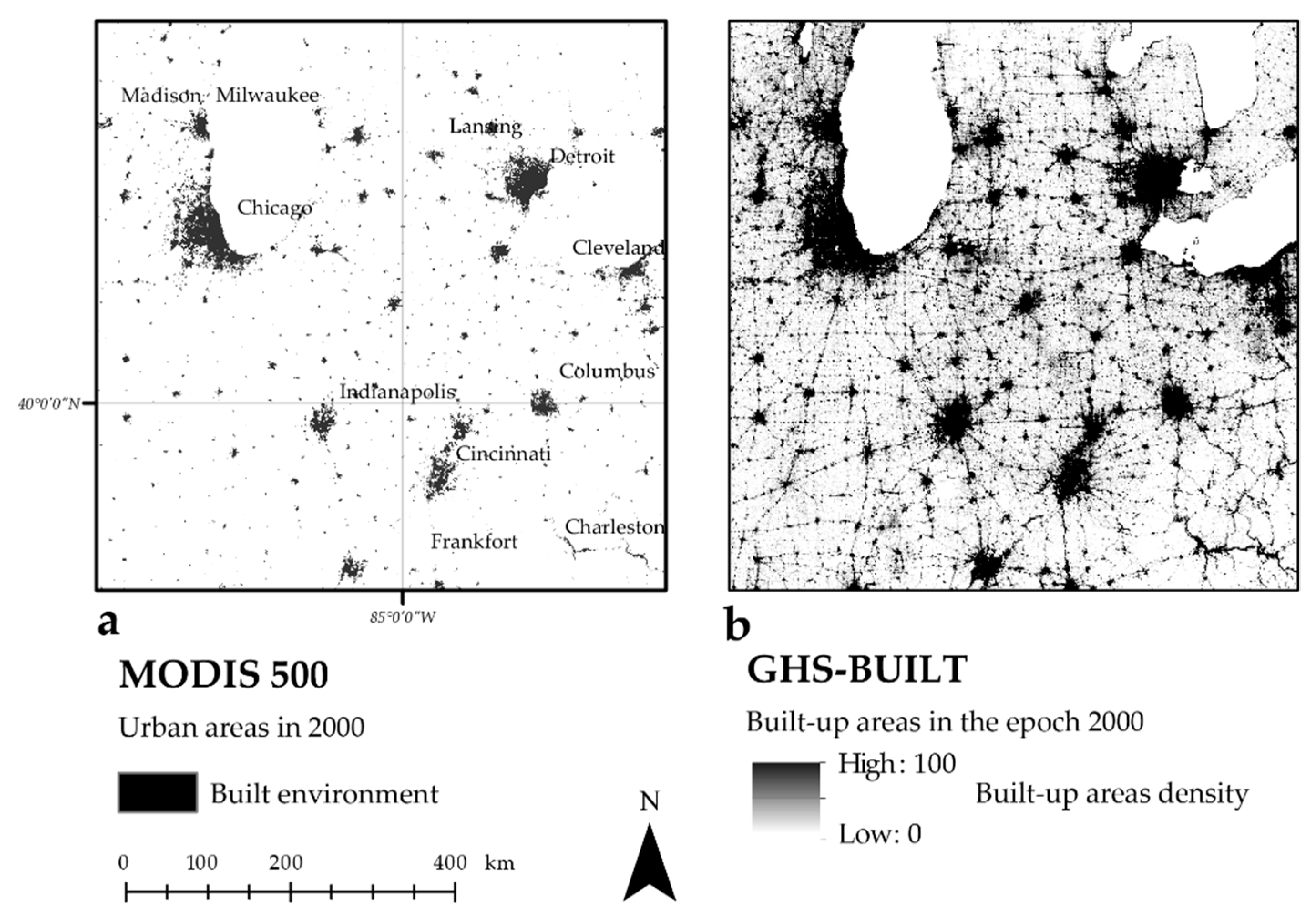
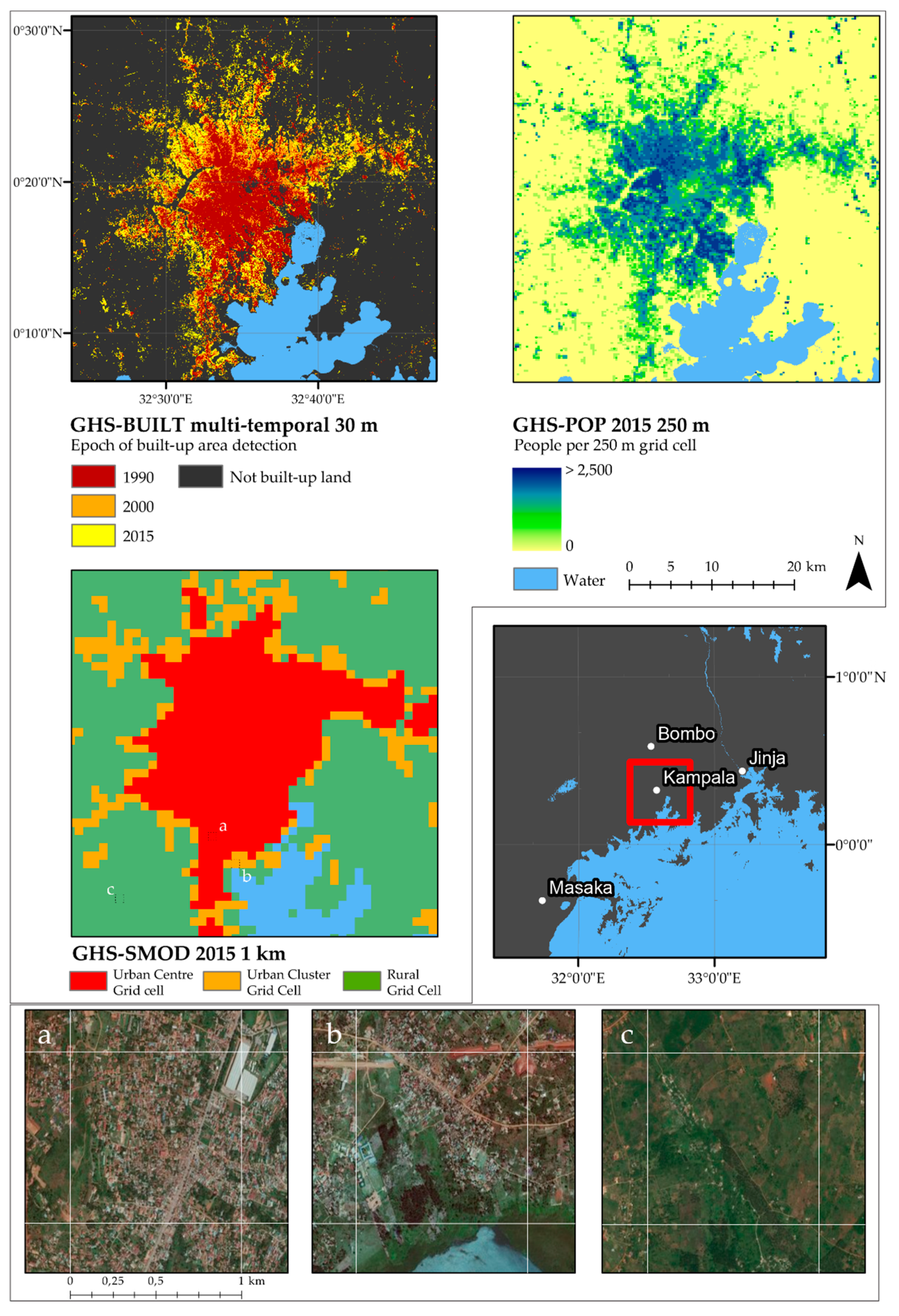
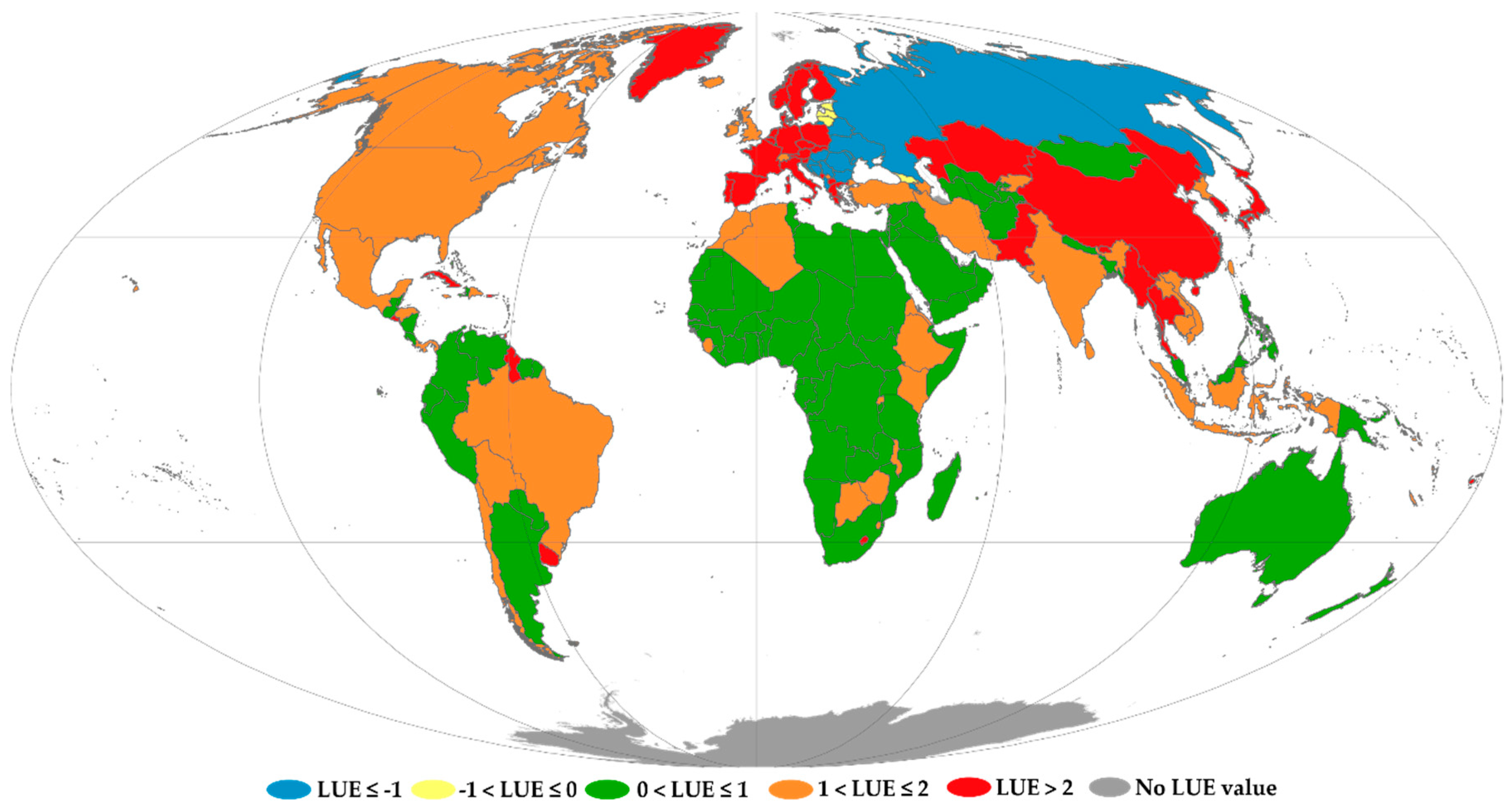
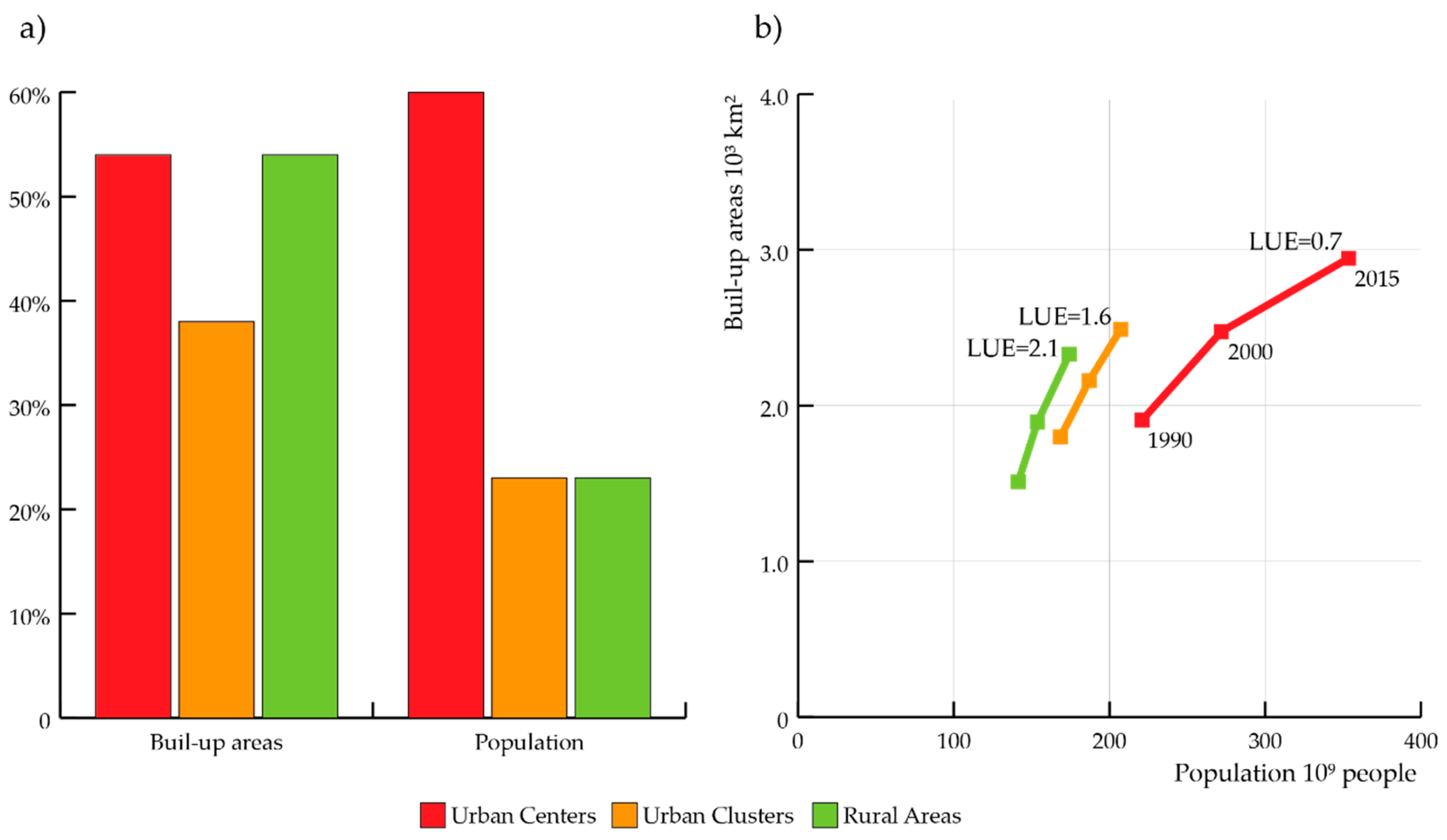
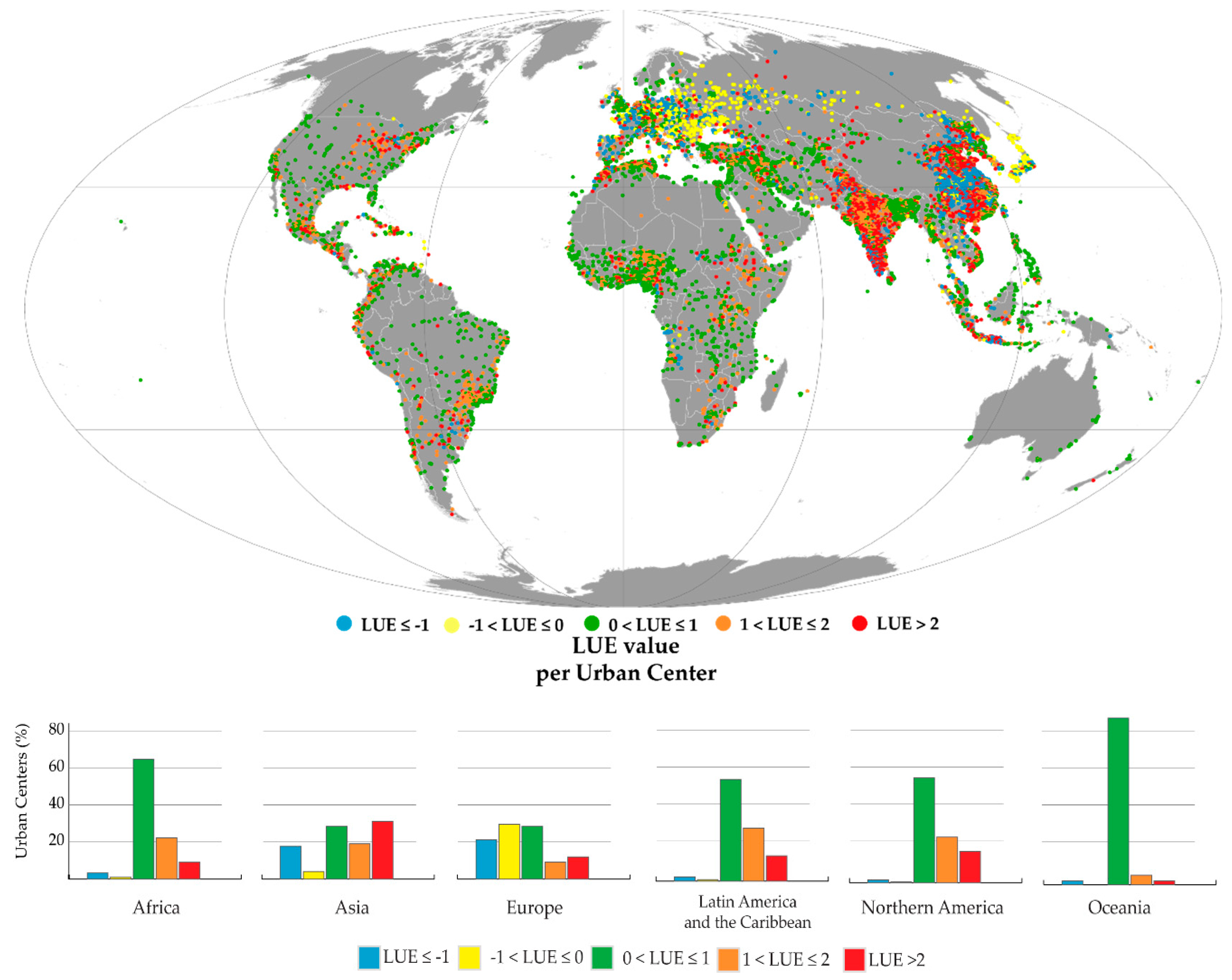
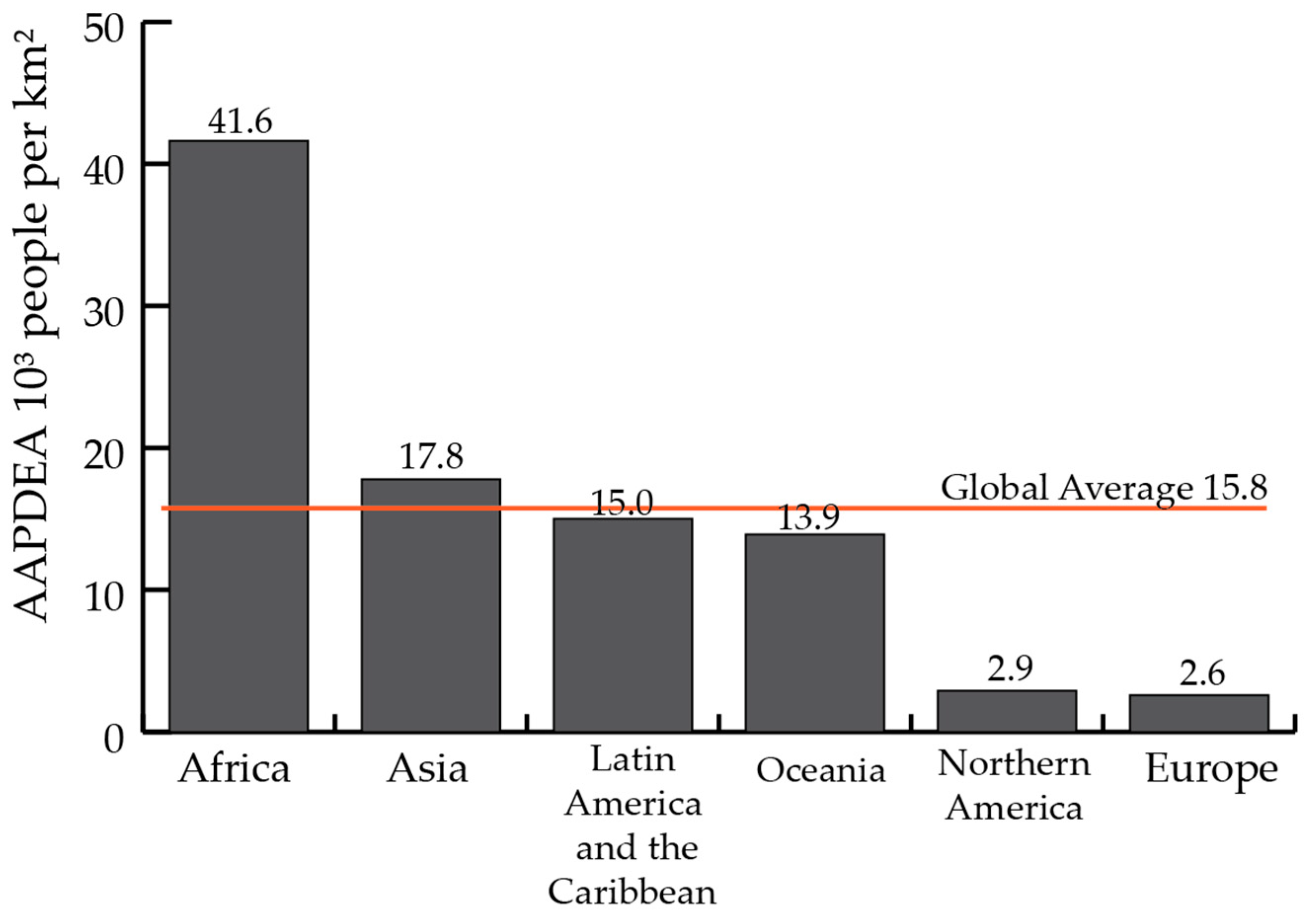
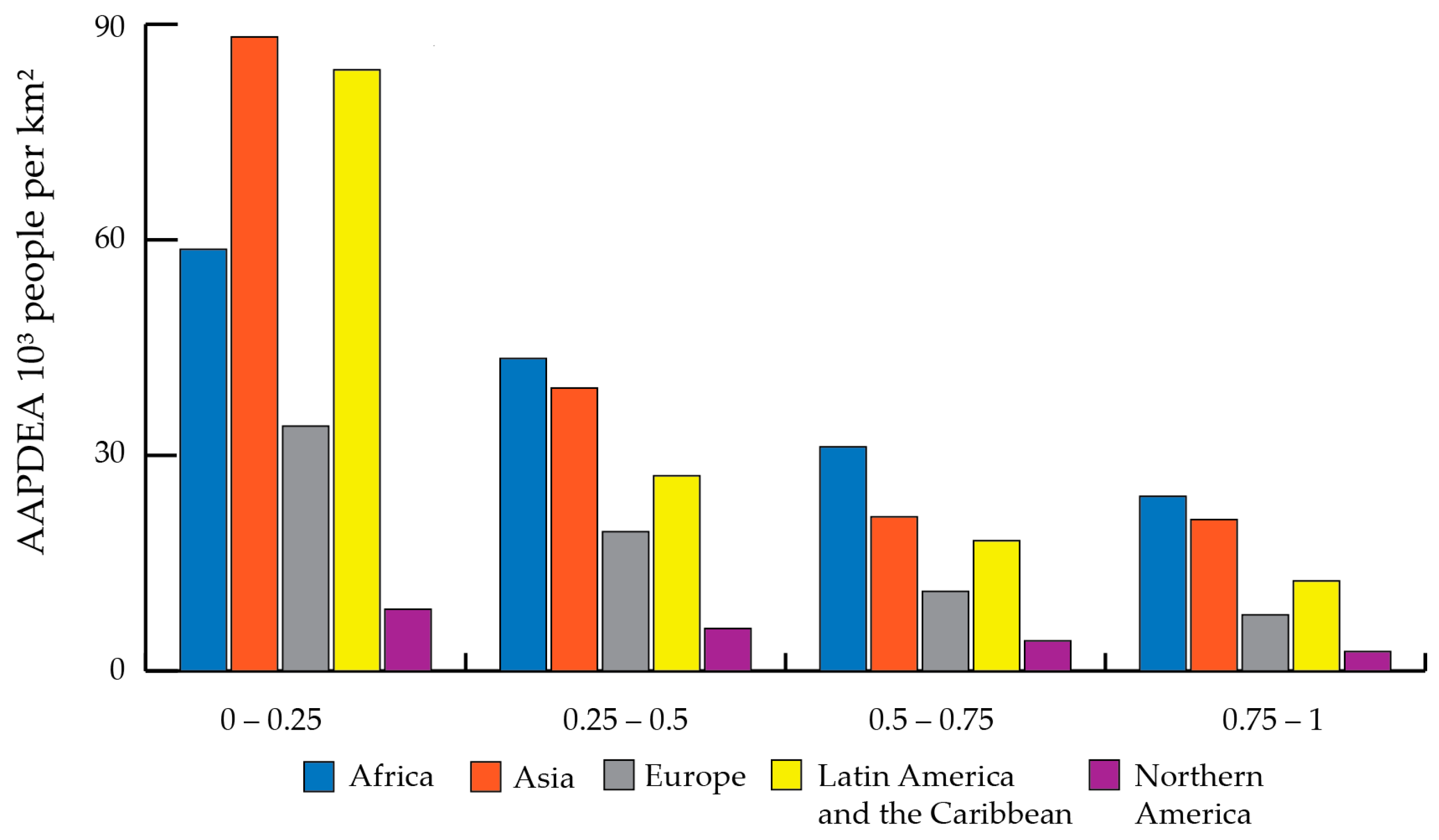
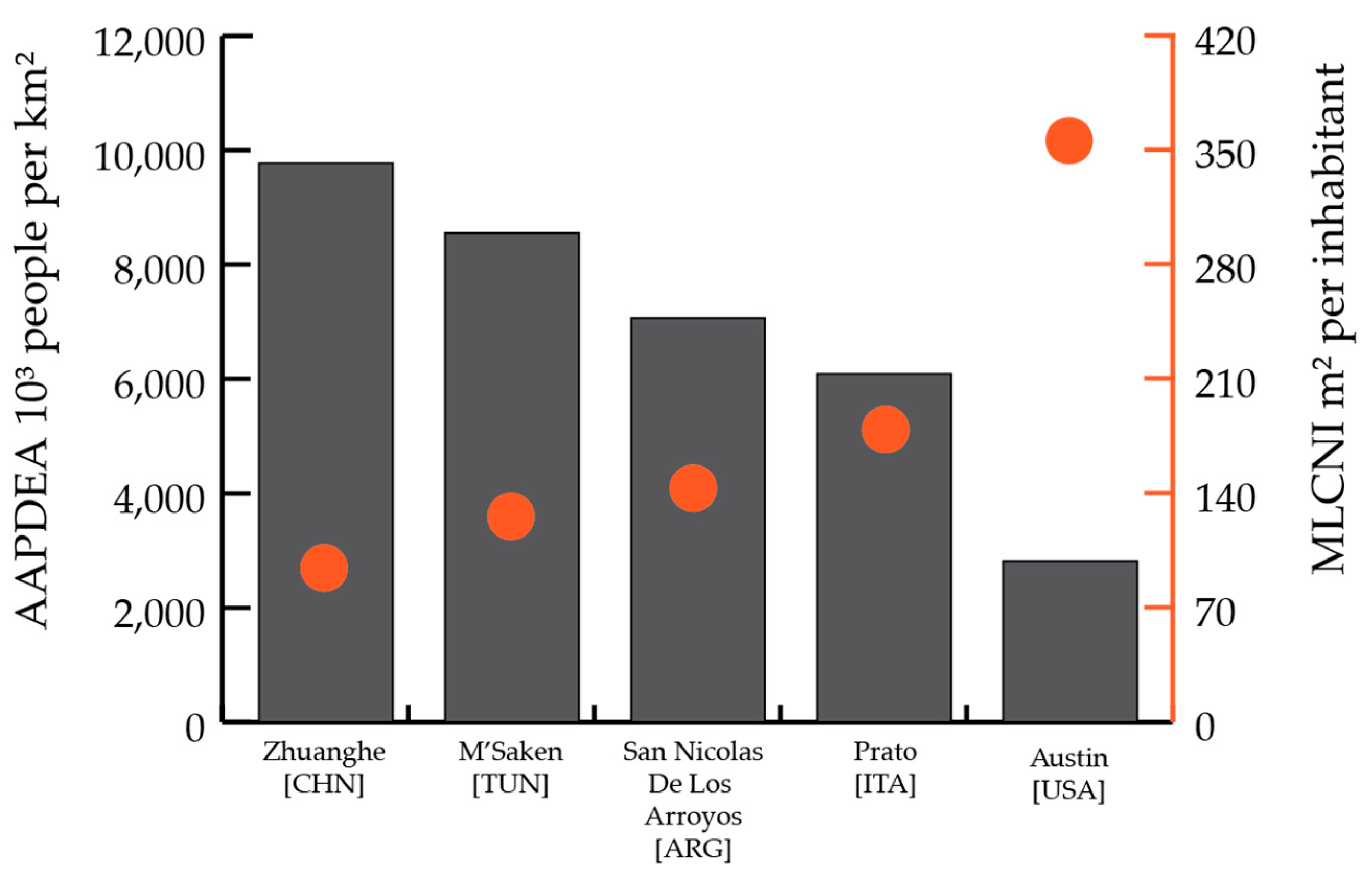
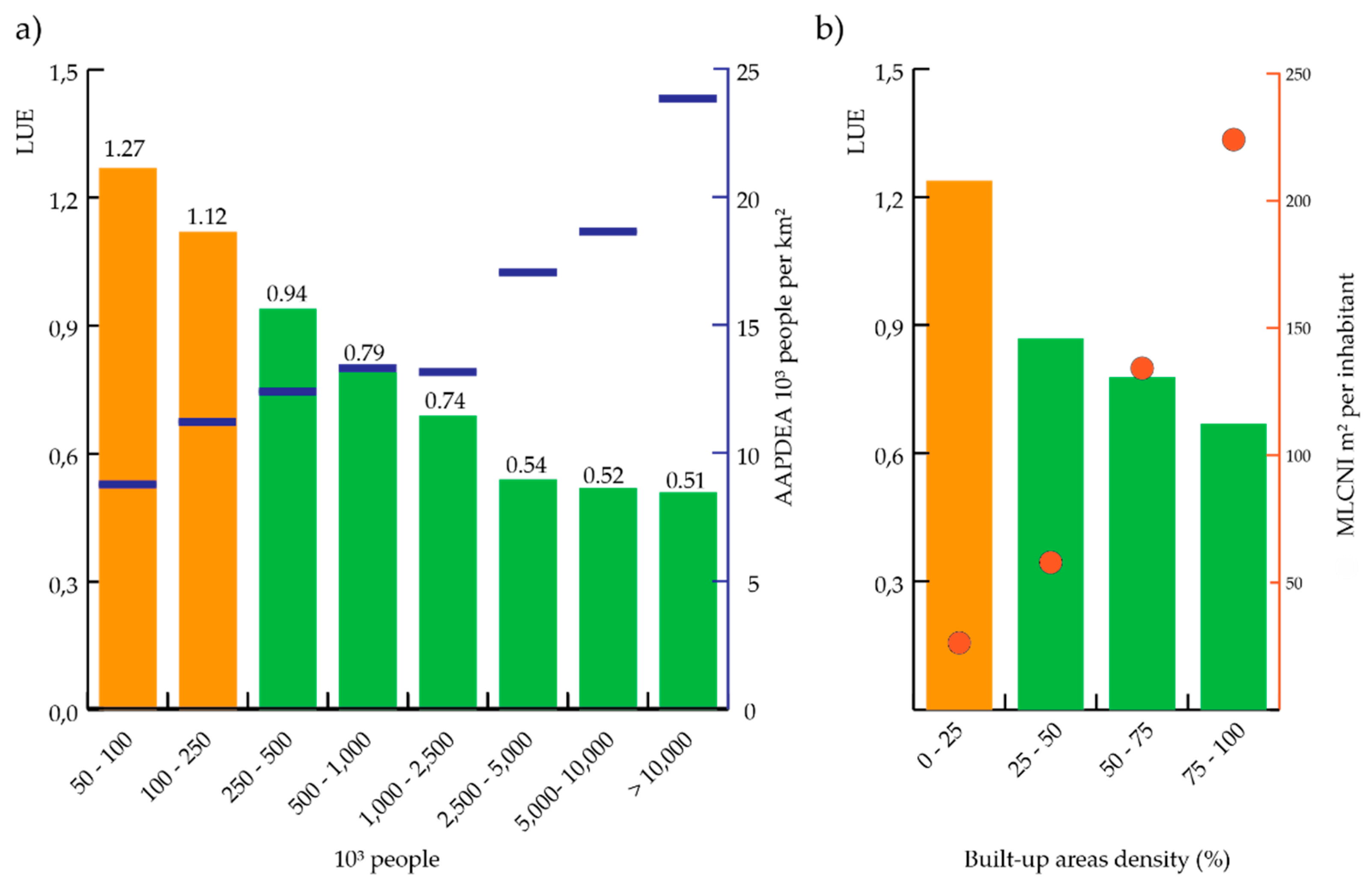
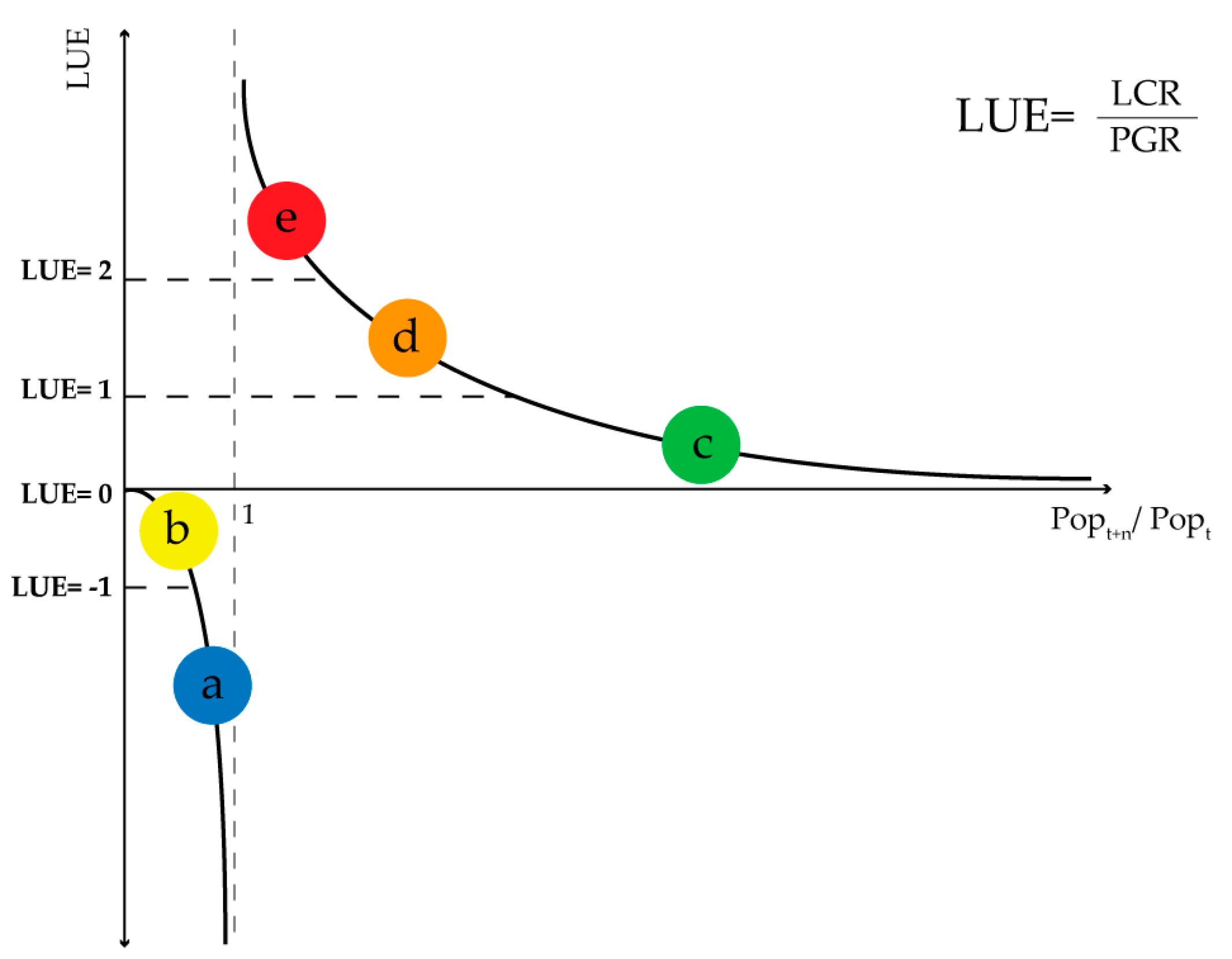
| Name | Semantic | Main Input Data | Epoch | Grid Resolution |
|---|---|---|---|---|
| GHS-BUILT | Density of built-up area per grid cell | Satellite imagery (Landsat) | 1975 1990 2000 2015 | 1 km |
| GHS-POP | Population counts per grid cell | Census data (CIESIN GPW), GHS-BUILT | ||
| GHS-SMOD | Classification of each grid cell into one of the Settlement Model classes: urban centres, urban clusters, and rural cells | GHS-BUILT, GHS-POP |
| Built-Up Areas (103 km2) | Population (106 people) | LUE | Relative Change 1990–2015 | ||||||||
|---|---|---|---|---|---|---|---|---|---|---|---|
| 1990 | 2000 | 2015 | 1990 | 2000 | 2015 | 1990–2000 | 2000–2015 | 1990–2015 | Built-up areas | Population | |
| Africa | 27 | 36 | 42 | 632 | 814 | 1186 | 1.1 | 0.4 | 0.7 | 54.4% | 87.8% |
| Asia | 189 | 244 | 303 | 3202 | 3714 | 4393 | 1.7 | 1.3 | 1.5 | 60.7% | 37.2% |
| Europe | 146 | 169 | 192 | 721 | 726 | 738 | 20.2 | 7.8 | 11.6 | 31.8% | 2.4% |
| Latin America and the Caribbean | 35 | 46 | 54 | 447 | 527 | 634 | 1.6 | 0.8 | 1.2 | 51.2% | 42.0% |
| Northern America | 116 | 148 | 175 | 281 | 314 | 358 | 2.2 | 1.2 | 1.7 | 50.6% | 27.5% |
| Oceania | 8 | 9 | 10 | 27 | 31 | 39 | 0.9 | 0.5 | 0.6 | 25.7% | 45.9% |
| Global | 522 | 653 | 777 | 5310 | 6127 | 7349 | 1.6 | 1.0 | 1.2 | 48.8% | 38.4% |
| Built-Up Areas (103 km2) | Population (106 People) | LUE | Relative Change 1990–2015 | ||||||||
|---|---|---|---|---|---|---|---|---|---|---|---|
| 1990–2000 | 2015 | 1990 | 2000 | 2015 | 1990–2000 | 2000–2015 | 1990–2015 | Built-up areas | Population | ||
| Africa | 17 | 21 | 24 | 289 | 380 | 562 | 0.8 | 0.3 | 0.5 | 38.7% | 94.5% |
| Asia | 88 | 109 | 123 | 1506 | 1788 | 2143 | 1.3 | 0.7 | 1.0 | 40.9% | 42.3% |
| Europe | 41 | 44 | 45 | 275 | 279 | 287 | 4.7 | 1.4 | 2.5 | 11.6% | 4.5% |
| Latin America and the Caribbean | 22 | 27 | 29 | 246 | 291 | 352 | 1.2 | 0.4 | 0.8 | 32.3% | 42.9% |
| Northern America | 56 | 65 | 69 | 134 | 151 | 172 | 1.3 | 0.5 | 0.9 | 23.8% | 28.3% |
| Oceania | 4 | 4 | 5 | 13 | 15 | 19 | 0.4 | 0.1 | 0.3 | 11.0% | 51.1% |
| Global | 227 | 269 | 295 | 2463 | 2904 | 3535 | 1.0 | 0.5 | 0.7 | 29.9% | 43.6% |
| Built-Up Area Change 1990–2015 | Population Change 1990–2015 | |||||||
|---|---|---|---|---|---|---|---|---|
| Region/LUE Class | 0–0.25 | 0.25–0.5 | 0.5–0.75 | 0.75–1 | 0–0.25 | 0.25–0.5 | 0.5–0.75 | 0.75–1 |
| Africa | 14% | 28% | 46% | 77% | 47% | 42% | 26% | 34% |
| Asia | 11% | 23% | 37% | 54% | 36% | 29% | 26% | 30% |
| Europe | 4% | 9% | 12% | 17% | 5% | 5% | 9% | 5% |
| Latin America and the Caribbean | 12% | 27% | 36% | 46% | 31% | 23% | 37% | 25% |
| Northern America | 8% | 17% | 24% | 32% | 9% | 17% | 8% | 13% |
| Urban Centre | MLCNI (m2 inhabitants) | AAPDEA (inhabitants per km2) | Built-Up Area Change | Population Change |
|---|---|---|---|---|
| Zhuanghe [CHN] | 102.3 | 9.771 | 29.2% | 29.1% |
| M’Saken [TUN] | 116.9 | 8.555 | 33.8% | 33.8% |
| San Nicolas De Los Arroyos [ARG] | 141.6 | 7.064 | 13.1% | 13.1% |
| Prato [ITA] | 164.2 | 6.090 | 12.0% | 12.0% |
| Austin [USA] | 355.1 | 2.816 | 59.4% | 59.6% |
| Semantic | GHSL Abstraction | Implications and Generalizations |
|---|---|---|
| AOI | GHS-SMOD 1 km |
|
| LCR | GHS-BUILT 30 m |
|
| PGR | GHS-POP 250 m |
|
| LUE | GHS-BUILT, GHS-POP, GHS-SMOD informing the UNDESA metadata |
|
© 2019 by the authors. Licensee MDPI, Basel, Switzerland. This article is an open access article distributed under the terms and conditions of the Creative Commons Attribution (CC BY) license (http://creativecommons.org/licenses/by/4.0/).
Share and Cite
Schiavina, M.; Melchiorri, M.; Corbane, C.; Florczyk, A.J.; Freire, S.; Pesaresi, M.; Kemper, T. Multi-Scale Estimation of Land Use Efficiency (SDG 11.3.1) across 25 Years Using Global Open and Free Data. Sustainability 2019, 11, 5674. https://doi.org/10.3390/su11205674
Schiavina M, Melchiorri M, Corbane C, Florczyk AJ, Freire S, Pesaresi M, Kemper T. Multi-Scale Estimation of Land Use Efficiency (SDG 11.3.1) across 25 Years Using Global Open and Free Data. Sustainability. 2019; 11(20):5674. https://doi.org/10.3390/su11205674
Chicago/Turabian StyleSchiavina, Marcello, Michele Melchiorri, Christina Corbane, Aneta J. Florczyk, Sergio Freire, Martino Pesaresi, and Thomas Kemper. 2019. "Multi-Scale Estimation of Land Use Efficiency (SDG 11.3.1) across 25 Years Using Global Open and Free Data" Sustainability 11, no. 20: 5674. https://doi.org/10.3390/su11205674
APA StyleSchiavina, M., Melchiorri, M., Corbane, C., Florczyk, A. J., Freire, S., Pesaresi, M., & Kemper, T. (2019). Multi-Scale Estimation of Land Use Efficiency (SDG 11.3.1) across 25 Years Using Global Open and Free Data. Sustainability, 11(20), 5674. https://doi.org/10.3390/su11205674






